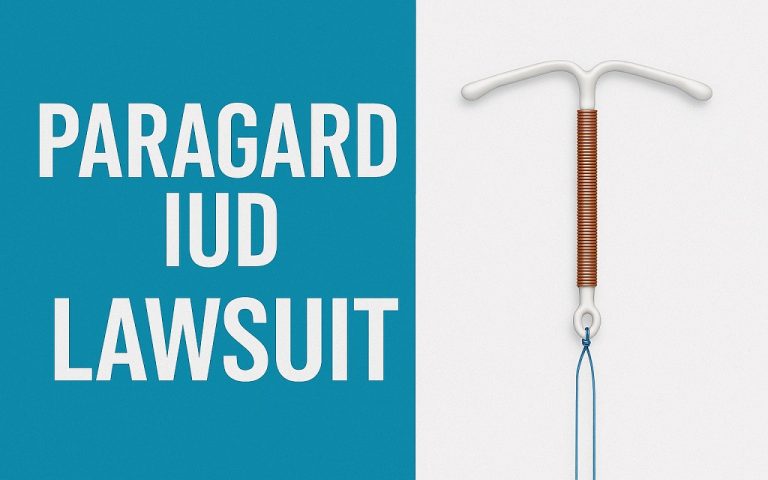You may have started using Monday shampoo expecting better hair health. You should be aware that the same product has now been associated with hundreds of customer reports of hair loss, scalp inflammation, and other adverse side effects. It is essential to understand how those symptoms connect to the growing legal concerns behind the Monday Shampoo Lawsuit.
You should read this article if you notice hair shedding, burning, or dryness after use. It explains what legal rights apply, how to report your injury, and what proof supports your case. The Monday Shampoo Lawsuit now highlights major questions about product safety, allergic ingredients, and cosmetic injury claims under U.S. law.
Every section uses clear language, step-by-step examples, and legal insights. You will learn how to identify harmful ingredients, maintain accurate medical records, and take action before deadlines expire. You should take the next step to protect your rights today.
What Is the Monday Shampoo Lawsuit and Why Does It Matter?
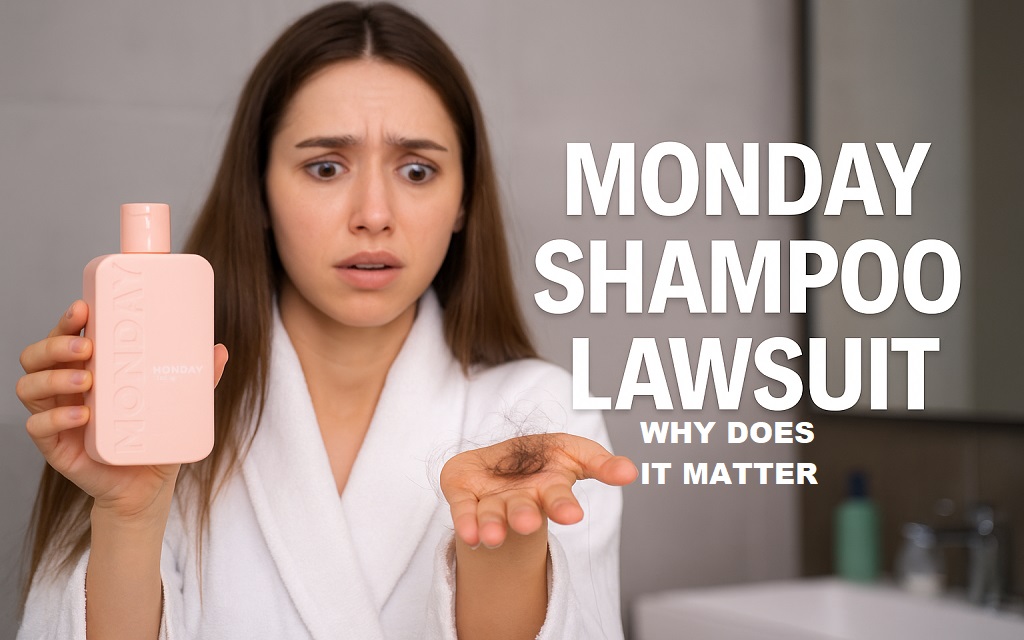
You may have seen reports of hair loss linked to Monday shampoo. It is crucial to understand how those claims led to legal scrutiny. You should be aware that online complaints have raised safety concerns about several product lines under the Monday Haircare brand.
Public allegations say that users suffered symptoms like scalp irritation, hair shedding, or redness after using Monday shampoo. Consumer videos began circulating across platforms like TikTok and YouTube. Legal interest followed soon after those videos gained attention from news outlets and dermatology experts.
You should understand how product lawsuits begin. Consumer injury cases often arise after multiple users report similar side effects. In most states, you can sue a company that sells a defective cosmetic product. Those lawsuits must prove actual harm, not just dissatisfaction with how a product worked.
Monday Haircare has not issued any product recall. As of today, no U.S. federal class action lawsuit has been certified against the company. Some people have indicated interest in joining a class action, even though no judge has yet to approve one. Customers can, however, pursue individual claims or contact lawyers who specialize in product liability law.
Legal scholars have validated the pattern. Over the past five years, hair loss and unidentified allergens have been at the focus of numerous shampoo-related claims. The product label, ingredient list, and any advertising statements regarding suitability or safety are frequently examined by courts.
You should save any purchase receipt or medical record if you believe Monday shampoo caused your injury. Those documents support your right to seek a remedy. In addition, regulators such as the FDA monitor these claims and sometimes investigate patterns that involve cosmetic harm.
Hair product injury claims fall under state and federal law. You may qualify to sue if you suffered symptoms and used the product as directed. You should read the rest of this article to learn how legal claims develop and what evidence helps your case.
What Part Did TikTok Play in Creating Consumer Concern?
TikTok may be where you first learned about the Monday shampoo dispute. It is essential to know how that platform shaped public awareness and legal attention. TikTok videos brought user complaints into the spotlight through short clips and personal testimony.
Creators posted videos showing hair falling out, red scalps, or patchy spots after shampoo use. You should know that some of those videos used hashtags like #MondayShampooLawsuit or #HairLossFromMonday. Those tags helped the content reach millions of viewers. Many creators asked if a lawsuit had started. Others claimed that Monday shampoo caused visible harm.
You should not confuse those videos with legal evidence. TikTok content often reflects personal experiences, rather than expert opinions. Still, courts and lawyers usually watch social media when patterns emerge. When hundreds of users show similar effects from the same product, legal professionals may take an interest. Content like that also draws media coverage and signals consumer risk to regulators.
Some dermatologists responded to those videos. According to them, those with sensitive scalps may experience adverse reactions when using shampoo. Experts have recognized scent allergies and preservatives as potential irritants. You should know that experts advised viewers not to panic or make fast decisions. Individual reactions differ according to personal traits, hair type, and skin condition.
Legal scholars explained why viral content matters. You should be aware that large volumes of user complaints can prompt companies to conduct internal investigations. Brands sometimes hire labs or revise formulas based on what surfaces online. In past lawsuits, TikTok videos were introduced as exhibits to show public concern or support injury claims.
Online comments under those videos often showed confusion, with viewers asking about ingredients or inquiring about how to file claims. You should treat TikTok as a sign of growing legal interest, not as legal proof. Actual court cases require documentation, medical diagnosis, and use history.
TikTok raised awareness about Monday shampoo. That awareness has now reached law firms, dermatologists, and newsrooms. You should use that momentum to learn how your own symptoms could fit into a legal strategy.
What Symptoms Could Indicate a Legal Injury from Shampoo Use?
You may wonder what symptoms count as legal injury in a shampoo lawsuit. It is essential to recognize the signs that courts and lawyers consider valid. Hair loss alone may not meet the legal threshold without supporting evidence.
Observe any symptoms that appear shortly after using the product. Itching, redness, and apparent irritation are typical symptoms, as is unexplained scalp shedding. Some users report burning sensations or swelling. Others observe brittle hair that breaks easily or patches of baldness.
Medical experts say that many of those symptoms are linked to irritating contact dermatitis or allergic contact dermatitis. You should know that allergic reactions can worsen with repeated exposure. After switching products, if symptoms still exist, it may be a sign of more serious harm.
Courts look for consistency in timing. Make a record of when you started using shampoo, when your symptoms began, and how they developed. Verification of the timing and diagnosis by a dermatologist strengthens injury claims. Most lawyers ask for before-and-after photos, doctor visits, and any patch testing done.
Legal weight is given to symptoms that involve visual harm or physical suffering. Any scarring, loss of hair density, or damage to the scalp should be documented using time-stamped photographs. Using screenshots from calendars, health apps, or even old selfies, you may support your version of events.
The severity of the injury also impacts claim strength. Describe the impact it has on your daily activities. This could involve experiencing mental distress, delaying activities, or missing work. Legal complaints often include both physical and emotional consequences.
Product injury lawsuits rely on explicit cause-and-effect claims. You should collect all health records, prescriptions, and dermatology notes that mention the shampoo or symptoms. If you told your provider about the product, that fact may link the condition to the ingredient list.
Symptom documentation forms the base of your case. Holding brands responsible is more difficult in the absence of documentation, images, or treatment histories. Take quick action if you see any indications of damage, particularly if the product label mentions alcohol, scent, or preservatives.
Which Ingredients in Monday Shampoo Raise Legal Questions?
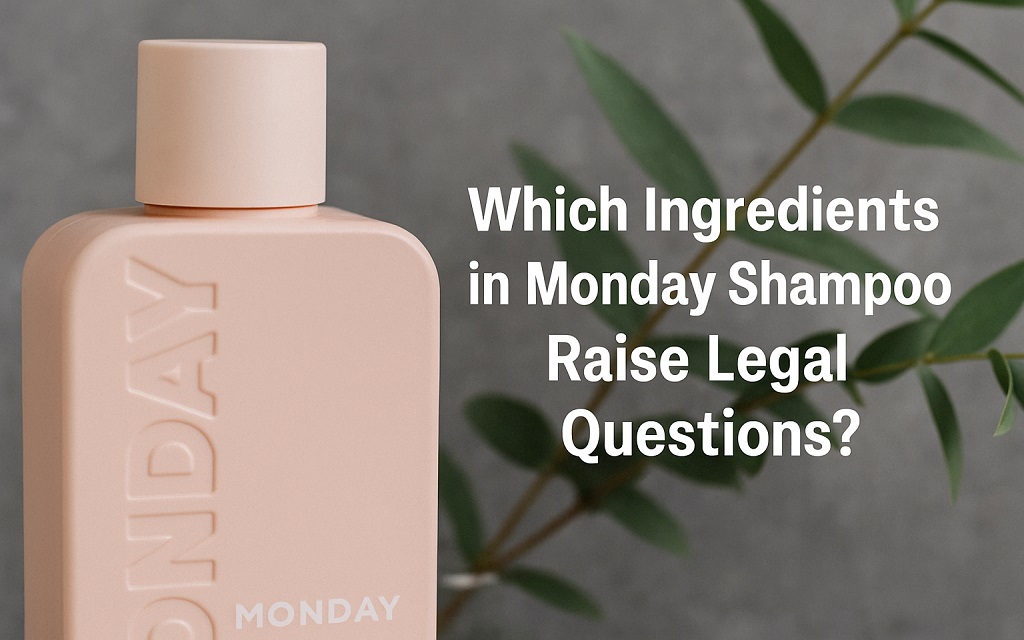
You should look closely at the ingredient list on every bottle of Monday shampoo. It is essential to know which substances may raise health or legal concerns. Many lawsuits begin after users react to common preservatives or fragrances found in cosmetic products.
You may find the following chemicals on Monday shampoo labels:
- Phenoxyethanol
- Benzyl alcohol
- Ethylhexylglycerin
- Fragrance (Parfum)
- Linalool
- Citronellol
- Hexyl cinnamal
- Geraniol
Some of those substances can cause allergic reactions in people with sensitive skin. Experts know them as contact allergies or irritants. Whether the business neglected to warn of specific hazards is a common topic of legal claims. A shampoo company that targets “sensitive scalps” would face additional regulatory scrutiny if it includes fragrance allergies or alcohol-based preservatives.
Cosmetic labels frequently list fragrance mixes. You should understand that “Parfum” hides many ingredients under one word. Brands do not need to list the exact breakdown. If you suffer a reaction, your dermatologist may recommend patch testing for common fragrance chemicals.
Benzyl alcohol and phenoxyethanol act as preservatives. They help prevent bacteria or mold. You should know that both can dry out the scalp or cause burning in some users. Courts have reviewed claims tied to those chemicals in past haircare lawsuits.
Natural-sounding names like linalool or citronellol come from essential oils. You should not assume that plant-based means safe. Some of those ingredients create allergic reactions under sunlight or heat. Dermatitis experts have published studies about reactions linked to citrus- or floral-scented additives.
You should review ingredient labels and compare batches. A reformulated version may omit or swap one allergen. If your reaction happened only after a specific bottle, that change could matter in court. A lawyer may request both ingredient versions to check for inconsistencies.
Every product has an INCI list. That list follows international naming standards. You should save the label from any bottle you used, especially if you experienced symptoms. Your injury claim depends in part on what that bottle contained.
Does Monday Shampoo Include Formaldehyde or DMDM Hydantoin?
As you may have heard, DMDM hydantoin can lead to allergic reactions or hair loss. Understanding that not all shampoos include that preservative is crucial. Don’t assume that the same component is used in all lawsuits; instead, read the labels of each product.
You should know that Monday shampoo does not list DMDM hydantoin as an ingredient in its core products. Ingredient audits of Moisture Shampoo, Smooth Shampoo, and Volume Shampoo confirm that. Consumer databases and product packaging show no trace of formaldehyde releasers in those SKUs.
DMDM hydantoin releases trace amounts of formaldehyde. Despite extending shelf life, some users may suffer from follicle damage or skin irritation. That particular chemical was the subject of previous litigation against other products, including Tresemmé and OGX. Courts reviewed expert testimony about how formaldehyde affects the scalp. In some cases, brands settled claims after negative publicity.
You should not assume that Monday shares the same legal exposure. MONDAY Haircare uses different preservatives. Their formulas rely on phenoxyethanol, benzyl alcohol, and ethylhexylglycerin. You should review labels for allergens, but exclude DMDM hydantoin from your concern unless future batches change.
Lawyers distinguish cases based on ingredients. You should know that DMDM hydantoin claims require different medical proof than fragrance allergy cases. A formaldehyde-based injury often involves long-term follicle damage or chemical burns. A fragrance allergy case may center on hives, flaking, or redness.
Exposure and concentration determine an ingredient’s safety. Leave-in treatments are often more hazardous than rinse-off products like shampoo, according to experts. However, with repeated exposure, the chance of a reaction increases. Every exposure incident should be recorded, particularly if your symptoms get worse over time.
Viral information claiming that DMDM hydantoin is present in all hair loss products should not be trusted. On Mondays, different shampoo formulas are utilized than on other days. The kind of evidence your lawyer would need and the manner in which your case would be presented in court are influenced by that knowledge.
Which Lawsuits Are Allowable Against a Shampoo Brand?
You should be aware of the legal theories that apply to cases involving shampoo injuries. Selecting the appropriate claim is essential when bringing a lawsuit. Under both state and federal law, courts permit a variety of causes of action in cases involving products.
You may bring a product liability claim—that type of lawsuit targets harm caused by unsafe or defective products. You should prove that the shampoo contained an ingredient or design that posed an unreasonable danger. Some courts allow claims based on design defects, while others require proof of manufacturing errors.
You may also claim failure to warn. That means the brand failed to disclose the risks associated with its ingredients. If you suffered a reaction that the company should have anticipated, you may qualify. Courts often ask whether the label gave fair notice to sensitive users.
You need to think about implied warranty violations. There is an implicit guarantee that every consumer product will function securely and efficiently. You may claim that the shampoo didn’t meet its warranty if it hurt you when you used it as directed.
False advertising laws may apply. You should know that if the label promises safety for all hair types or claims dermatologist approval, you may have a claim if your injury contradicts those assurances. Lawyers use screenshots, label images, or archived web pages to support those cases.
Negligence claims are also common. You may allege that the company acted carelessly in testing or formulating the product. When a business disregards warning indications or neglects to look into customer concerns, that theory might be applicable.
You need to consult with an attorney who specializes in personal injury law. Most cosmetic injury lawsuits use two or more theories in one complaint. You may also file under consumer protection statutes that allow extra damages.
Legal success depends on more than your story. You should present strong proof, medical notes, and ingredient analysis. That evidence supports every legal claim and helps build a strategy that fits your facts and local law.
How Can You Prove That a Shampoo Caused Your Injury?

You should prepare to show clear links between shampoo use and injury. It is essential to know that courts expect more than personal opinion. Strong evidence makes the difference between a denied claim and a successful result.
You should document every stage of your experience. Start by writing the date you began using the shampoo. Record how often you applied it—Mark, when the symptoms first appeared. Photos and videos help support your timeline. You should save dated selfies, calendar entries, and journal notes.
Medical documentation strengthens your position. You should see a dermatologist or primary care doctor as soon as you notice symptoms. Ask the doctor to record product use in your medical history. Diagnosis codes, such as L65.9 (nonscarring hair loss) or L23.5 (allergic dermatitis), help establish causation in health records.
Receipts and proof of purchase matter. You should find order confirmation emails, loyalty program records, or bank statements that show the product purchase. If the bottle remains in your home, save it. Batch numbers on the label may help your lawyer match the product with manufacturing data.
You should identify the ingredients in your bottle. Product formulas sometimes change. A label image from your specific bottle carries more weight than one from a website. Courts expect precise product identification, especially when ingredients may vary across versions.
Legal causation means more than correlation. You should rule out other causes such as medications, hormones, or unrelated skin conditions. That step shows good faith and makes your case stronger. A patch test or scalp biopsy may help prove your body reacted to the product.
Statements from employers, family, or stylists may help. If they noticed sudden hair thinning or scalp redness, their observations may support your claim. You should collect those statements as soon as possible while your memory remains fresh.
You should gather every possible document before speaking with a lawyer. That preparation shows you understand the burden of proof. Courts expect that in every product injury claim.
What Role Does MoCRA Play in Cosmetic Injury Reporting?
You should learn how MoCRA affects cosmetic product safety. It is essential to understand that the Modernization of Cosmetics Regulation Act is known as MoCRA. In 2022, Congress enacted the measure to strengthen the regulation of the beauty sector.
You should be aware that MoCRA now mandates that businesses notify the FDA of significant adverse events. This regulation covers symptoms such as hospitalization, chronic damage, deformity, or allergic responses that necessitate medical attention. If you experienced those effects after using Monday shampoo, your case may fall under MoCRA.
MoCRA gives the FDA authority to collect and track reports. You should file your complaint using FDA Form 3500. That form appears on the MedWatch portal. It allows you to describe symptoms, upload receipts, and list the product name and batch code.
Cosmetic brands must also respond to serious injury claims. You should be aware that, under MoCRA, manufacturers are required to maintain records for at least six years. Lawyers may request documentation during a lawsuit.
You should understand that MoCRA does not create automatic recalls. The law gives the FDA power to issue mandatory recalls only after companies refuse voluntary ones. If Monday shampoo receives multiple reports under MoCRA, the agency may issue warnings or seek corrective action.
You may file an adverse event report even if you do not plan to sue. You should take that step to help regulators find trends. Past lawsuits involving products like DevaCurl or OGX included FDA reports in their legal filings. That evidence showed a wider risk beyond individual users.
MoCRA applies to all U.S. cosmetic products. You should check whether your shampoo bottle was bought in the United States and includes a U.S. label. International versions may follow different rules.
You should consult a lawyer if your symptoms require medical attention. MoCRA supports your injury claim by confirming that shampoo harm fits into federal tracking systems. That confirmation may help persuade courts or settlement teams.
Can You Join a Class Action Lawsuit Against Monday Haircare?
You may wonder if a class action has started against Monday Haircare. It is essential to know how class actions work before you decide to join one. You should understand what courts require before they allow class treatment of injury claims.
No certified class action exists yet against Monday Haircare. You should know that several lawyers have posted intake forms online. Some firms collect stories in case future action becomes viable. That step does not mean a judge approved class status.
A class action combines many similar claims into one case. You should know that courts approve classes only when the legal and factual issues match across the group. That standard includes:
- Common questions of law and fact
- Injuries caused by the same product
- Use of the product in similar ways
- Shared damages or harm types
You should know that cosmetic injury cases often differ by skin type, allergy history, and application method. That variety makes class certification harder in hair loss cases. Some judges deny class actions because each plaintiff needs a separate expert.
You may qualify for individual legal action even if no class forms. You should consult with a personal injury lawyer who specializes in cosmetic harm. Lawyers sometimes coordinate similar cases as mass torts instead of class actions. Mass torts share experts and resources but allow separate payouts based on each person’s harm.
Class action lawsuits follow strict procedures. You should know that courts require formal notices and opt-in or opt-out choices. If a class forms in the future, you will likely receive notice by email, mail, or public posting.
You should keep records now, even if no lawsuit exists. Batch codes, medical records, and receipts help you respond quickly if legal options expand. Class actions evolve fast once data supports group-wide harm. You should stay alert and prepared in case your symptoms match future class members.
Have Courts Approved Similar Hair Loss Lawsuits Before?
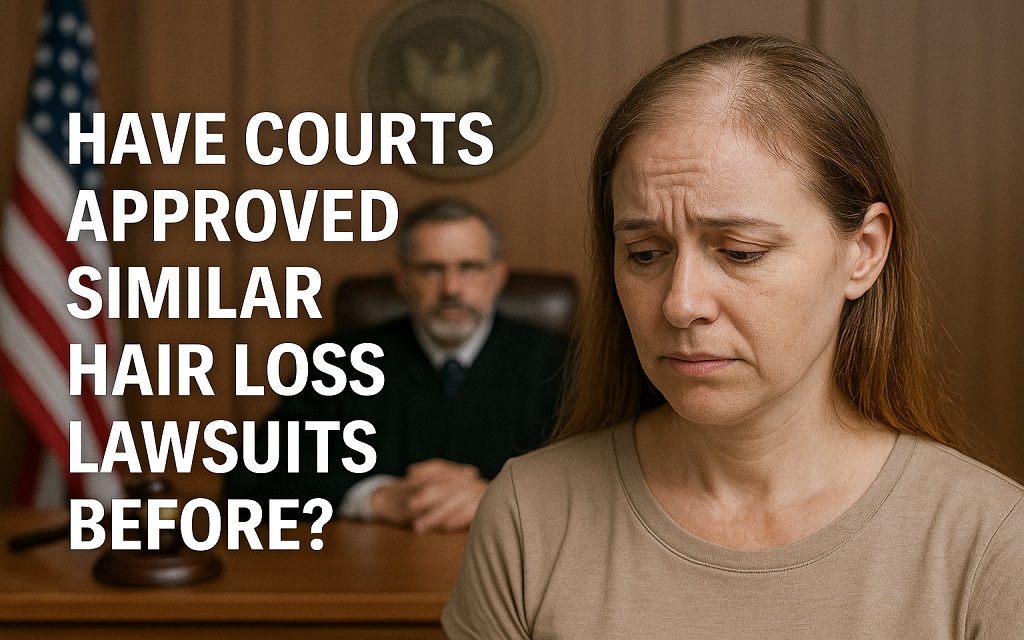
You should understand how courts have handled similar shampoo-related lawsuits. It is essential to look at legal history to assess the chance of success. Past hair product claims illustrate how judges assess evidence, injuries, and product formulations.
You should know that courts have reviewed lawsuits against brands such as Tresemmé, OGX, and Monat. DMDM hydantoin or other preservatives were frequently used in certain circumstances. The plaintiffs said that the shampoos resulted in chemical burns, irritation of the scalp, and hair loss.
Users claimed that DMDM hydantoin exposed them to formaldehyde in the Tresemmé lawsuit. Some plaintiffs claimed scarring alopecia or permanent hair damage. Courts allowed parts of the lawsuit to proceed after expert opinions linked the preservative to follicle harm.
The OGX lawsuit raised similar issues. Users said that repeated use led to hair shedding and scalp pain. Johnson & Johnson settled several claims without admitting fault. You should know that those cases cited ingredient lists, expert dermatology notes, and batch data.
You should know that Monat faced class action filings over claims of misrepresentation and adverse reactions. Some plaintiffs submitted FDA complaints and dermatology records. Courts dismissed parts of the case but allowed others to proceed. That result shows how mixed outcomes often occur in beauty product claims.
Legal victories depend on strong documentation. You should study those examples to see what courts demand. Most successful plaintiffs provided before-and-after photos, patch test results, and scalp biopsy reports. Those details helped prove causation.
Each shampoo lawsuit turns on its facts. You should not assume that success against one brand means guaranteed success against another. Ingredient lists, product labels, marketing claims, and medical records all shape the court’s view.
Courts now take cosmetic harm seriously. If your symptoms match those in past lawsuits, you may qualify to file. You should speak to a lawyer who understands how those earlier cases played out and what made them survive dismissal.
How Much Is a Shampoo Injury Case Worth in Settlement?
You should understand how courts and lawyers value shampoo injury claims. It is essential to know that each case depends on specific facts. Settlement amounts vary based on the extent of harm and strength of evidence.
You may expect payouts between $5,000 and $75,000 in many shampoo injury cases. Some outliers reach higher figures, primarily if permanent hair loss or scarring occurs. Courts consider both physical and emotional impact when calculating damages.
You should present medical bills, photos, and diagnostic records. Those documents help prove the severity of your injuries. If you missed work, you may include lost wages. You should also describe the daily impact, such as missed events or mental distress.
Lawyers use a formula that combines economic and non-economic damages. Financial losses include treatment costs, travel to specialists, and lost income. Non-economic losses reflect pain, embarrassment, and reduced quality of life. You should know that stronger evidence raises both types of compensation.
You should expect more in claims that involve visible disfigurement or doctor-confirmed scalp damage. Judges often award higher amounts when hair loss creates lasting appearance changes. That applies especially to younger plaintiffs or public-facing professionals.
Settlement value increases when multiple people show the same symptoms. Lawyers sometimes group claims to pressure brands during negotiations. You should document your symptoms fully so that you can participate in that effort if your claim qualifies.
Insurance coverage also affects payout limits. Some cosmetic brands hold product liability policies with caps. You should know that settlement talks factor in those limits. If several claims exceed the cap, courts may approve partial payouts.
You should work with a lawyer who understands personal injury valuation. Each fact you present improves your negotiation leverage. Past shampoo lawsuits show that strong medical proof often leads to higher compensation without a trial.
You should begin building your file now. The sooner you assemble records, the easier it becomes to calculate your damages and move toward a fair settlement.
What Defenses Can a Shampoo Brand Use in Court?
You should prepare for common defenses that brands raise in product injury lawsuits. It is essential to know how companies respond when accused of causing harm. These defenses may influence whether a court allows your case to proceed.
The brand may argue safe use when applied as directed. You should expect the company to claim that most users suffer no harm. Courts often weigh statistical safety against individual complaints. A company can submit expert testimony or customer satisfaction data to defend the formula.
You may hear that the reaction resulted from personal sensitivity. Brands often argue that allergy risk varies by user. If no label promises hypoallergenic results, that point may carry weight. You should be aware that dermatology records can help counter that claim by linking your reaction to specific ingredients.
A brand may argue that another product caused the symptoms. You should expect questions about other hair treatments, medications, or underlying skin conditions. If your health history includes alopecia, psoriasis, or hormone changes, you must address that in your case.
Please note that improper storage or use of expired products may occur. A defense team may claim that you left the bottle open in the heat or applied an excessive amount of product. If your bottle passed its shelf life, that fact may reduce the value of your claim.
Marketing statements also create defenses. If you relied on ads that said “for all hair types,” the company may argue that those words do not mean allergy-free. You should save screenshots or packaging that uses firm promises. That language may support your counterargument.
Ingredient approvals may appear in court. You should know that brands often point out that the FDA allows the listed ingredients. That fact alone does not excuse harm, but it may help defend against claims of negligence.
You should prepare for every argument the brand may use. That way, your lawyer can rebut each point with facts, documents, and medical records. Good preparation shows judges that your case deserves a full hearing.
Where Should You Look for the Batch Code on Your Bottle?

You should locate the batch code on your shampoo bottle as soon as possible. It is crucial to preserve that code because it links your injury to a specific product run. Courts and regulators often require batch-level data when assessing product harm.
You should look near the bottom of the bottle. Most Monday shampoo products print the batch number in small black ink. That code may appear under the barcode, along the edge of the bottle, or directly on the cap. In some cases, it may follow a “LOT” label or appear as a date string.
Take a clear photo of the code. You should also write it down with the date and store that note with your other documentation. A batch code can connect your bottle to others with similar injury reports.
You should be aware that manufacturers typically track batch codes internally. Each batch reflects a specific production run. Brands keep those records under FDA rules, especially after MoCRA took effect. If other users with the same code report symptoms, your lawyer may request recall or lab data from that run.
You should also match the batch code with the product label. Sometimes the formula changes between batches. A batch made in early 2023 may include different ingredients from one made in late 2024. That difference matters when proving causation.
If you threw the bottle away, you should check old photos or order receipts. Some e-commerce platforms list batch numbers in your account history. You may also contact customer service to retrieve that data.
You should know that batch codes form the first step in product traceability. Courts rely on that link to connect claims across users. Without it, brands may argue that your symptoms came from another source.
You should not delay. The longer you wait, the harder it becomes to find or verify that code. You should store the bottle safely and include the batch photo with every intake form or legal inquiry.
What Happens If You Have Already Discarded the Shampoo Bottle?
You may feel concerned if you no longer have your shampoo bottle. It is essential to know that you can still support your legal claim without it. Courts recognize that many users dispose of personal care products before learning they caused harm.
You should begin by checking old receipts. Your purchase history may show the exact product type and purchase date. Most retailers include Monday shampoo under a line item with a product code. If you ordered online, the order confirmation email may consist of SKU details.
Photos also matter. You should look through your camera roll or cloud gallery. If you posted a review or sent a message showing the product, save that image. A photo of the label, bottle shape, or bathroom shelf may help prove use.
Your medical timeline supports causation. You should show when you started using the shampoo and when your symptoms began. If you reported the product to a doctor, that reference in your records supports your case even without the bottle.
You should write a product statement. Please describe the bottle’s appearance, where you purchased it, and how you used it. Talk about the color, size, and aroma of the bottle. That level of detail helps lawyers connect your version to known Monday SKUs.
Friends or family may help. You should ask if anyone noticed your product at home. Witness statements may confirm that you owned and used the brand.
You should not worry if the bottle is missing. Many lawsuits succeed using secondary proof. That includes receipts, photos, medical records, and personal statements. You should gather all of those materials now before the details fade.
You may also contact the seller. Some stores track batch codes for returns. If you paid by credit card or used a loyalty account, that data may help recover your purchase history. Your lawyer may also subpoena that record later if needed.
What Do Dermatologists Use to Diagnose Shampoo Reactions?
You should be aware of the methods dermatologists employ to identify cosmetic product-induced scalp responses. It’s critical to get evaluated by a professional as soon as symptoms start to show. Early documentation helps prove causation and supports your legal claim.
A dermatologist will often start by visually inspecting your scalp. The physician will look for indications of thinning, scaling, redness, or inflammation. You should explain the product you used, how frequently you used it, and the onset of your symptoms.
Dermatologists may use a pull test. This involves gently tugging hair from different sections of the scalp. Please note that this test assesses active hair shedding and helps distinguish it from normal seasonal loss.
Scalp biopsies may be ordered in severe cases. The doctor removes a small skin sample and sends it to a lab. You should know that this test reveals patterns linked to allergic or chemical damage. Pathologists check for follicle destruction, inflammation, and scarring.
Trichoscopy may also be used. That tool magnifies the scalp to show follicle shape, broken hair, and scaling. You should request photos from that exam. Those images support visual proof if your case goes to court.
Patch testing may follow. You should be aware that you will be exposed to trace levels of allergens during this test. The doctor looks for redness, pimples, or swelling 48–96 hours later. The outcomes make it easier to connect components, such as preservatives or aroma, to your response.
Blood work is another tool that doctors use to rule out other explanations. Infections, autoimmune disorders, or hormonal imbalances can cause similar symptoms. To prevent confusion during diagnosis, you should mention all drugs and medical history.
You should ask for medical records and test results. Those documents provide the foundation for legal claims. ICD-10 codes such as L65.9 (nonscarring hair loss) or L23.5 (contact dermatitis) often appear in shampoo-related cases.
You should not delay. Your diagnosis will be more accurate the sooner you see a dermatologist. When assessing injury claims, courts prefer early and consistent treatment records.
How Much Time Do You Have to Bring a Lawsuit About Shampoo?
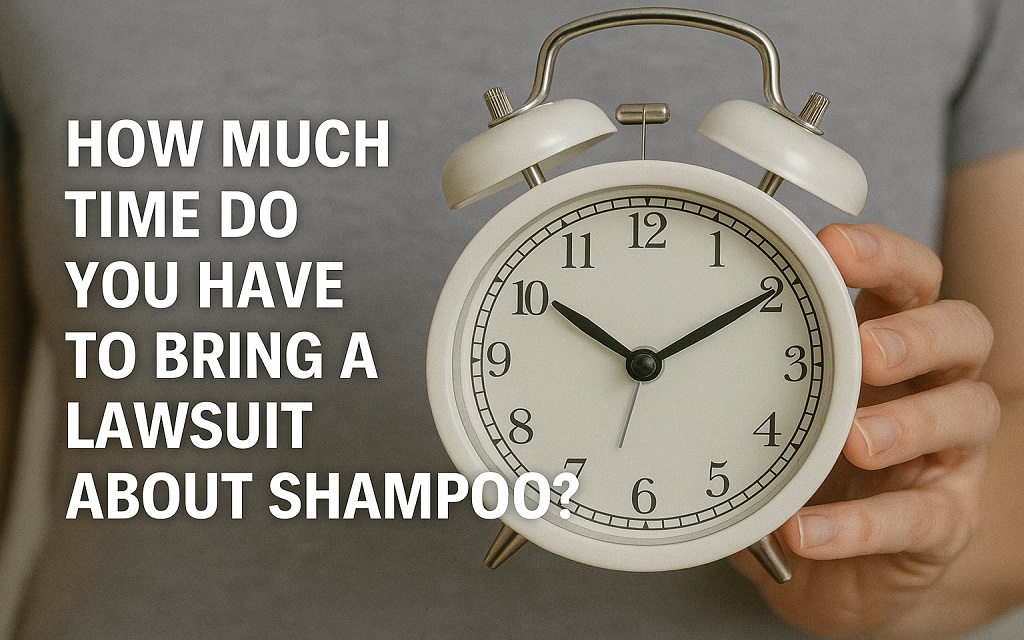
You should know that legal deadlines apply to all product injury claims. Filing your claim before the statute of limitations runs out is crucial. The deadline varies by state and is typically one to four years from the date of the accident.
The day you become aware of symptoms or discover the shampoo might have been harmful should be the start of your count. Some states use a discovery rule. If you were unable to logically link your symptoms to the product until later, that rule permits further time.
You should be aware that courts may reject your claim without a hearing if you wait too long. That result applies even if your injuries seem severe. You should act quickly to preserve your right to recover damages.
State statutes differ. In California, you may have two years. In Florida, you may have four. Additionally, in New York, you may face a three-year statute of limitations. You should ask a lawyer licensed in your state to explain the exact rule that applies.
You should also act fast if the shampoo causes symptoms in a child. Many states pause the clock until the child turns 18. Others allow a parent or guardian to file on the child’s behalf. You should confirm those rules early.
You should know that other legal limits may apply. If your injuries involve a government-run clinic, hospital, or insurer, you may face shorter deadlines under notice-of-claim laws. That rule may apply if public benefits paid for your care.
Your lawyer may ask when you first noticed hair loss, saw a dermatologist, or stopped using the product. That timeline helps calculate filing deadlines. You should gather those dates now before memory fades.
You should never assume you have more time. Each month that passes can reduce your options. You should contact a lawyer as soon as symptoms appear or medical notes mention product-related injury. That step preserves your right to file in court.
Why Can Ingredient Labels Help or Hurt Your Claim?
The ingredients listed on the label of your shampoo bottle should be carefully read. It is crucial to understand that such labels frequently determine the results of a cosmetic damage case. Courts use the product label to determine whether the brand disclosed known risks.
Each Monday, the shampoo bottle lists ingredients in descending order by weight. You should save a photo of the exact label from the bottle you used. Different formulas may exist across countries or batches. That detail matters when proving causation.
Please note that label changes can occur without notice. A brand may adjust its formula from year to year or across different product lines. If you reacted to a specific version, the ingredient list helps confirm which chemicals may have caused harm.
Labels also reflect marketing claims. Look for phrases like “safe for sensitive scalps,” “for all hair types,” or “dermatologist tested.” Your attorney may utilize that phrase to argue for misleading advertising or breach of warranty if your symptoms contradict those claims.
Look for recognized allergies such as benzyl alcohol, cinnamyl alcohol, or linalool. These compounds are listed as common irritants in dermatology standards. Your doctor may reference them in patch test results or diagnosis reports.
Additionally, make sure that no prohibited or contentious ingredients are present. Many modern products no longer include parabens, formaldehyde, or DMDM hydantoin. If your label indicates the presence of those chemicals, your case may involve stronger arguments regarding outdated formulas.
Ingredient labels serve as direct evidence in court. You should attach the label photo to your intake form when contacting a law firm. Without that proof, brands may argue you used a different version than the one under review.
You should store the bottle with the label intact. If it fades or peels, scan it or take multiple photos of the affected area. That record preserves the ingredient list in the exact condition it appeared when you suffered injury.
How Do Patch Tests Reveal Shampoo Allergen Reactions?
You should know that patch testing helps confirm allergy-based shampoo reactions. It is essential to ask your dermatologist about this option if you have suffered symptoms. That step provides objective proof that courts accept in product injury claims.
You can expect the test to be administered over several days. Your doctor places small samples of common allergens on patches. The doctor applies those patches to your back and marks the skin. You should avoid washing the area or sweating during the test period.
The doctor checks the test site after 48 hours and again after 72 or 96 hours. You should know that redness, swelling, or blistering at the contact point signals an allergic reaction. The dermatologist compares those results to ingredient lists in the product.
You should ask the doctor to test for fragrance mix, linalool, benzyl alcohol, and preservatives. Those substances often appear in Monday shampoo products. If your reaction matches a test spot, that strengthens your causation argument.
Your doctor may assign a grade to the reaction. Courts often accept positive patch test results as evidence. You should request a copy of the report with images, grades, and allergen names. You should include that report with your legal intake file.
Patch testing also helps rule out unrelated causes. If you show no reaction to shampoo ingredients, your lawyer may explore other explanations. That outcome does not end your case but changes the theory of harm.
You should undergo patch testing early in the process. The test provides medical clarity and legal weight. You should not rely on personal opinion alone when alleging harm.
You should ask your provider about test costs and insurance coverage. Some clinics perform only basic panels. For a more thorough evaluation, you might require a referral to a cosmetic or occupational dermatology specialist.
However, you should complete patch testing before filing your claim. That step demonstrates to courts and insurers that your case is based on science, not speculation.
What Mistakes Can Weaken Your Cosmetic Injury Claim?
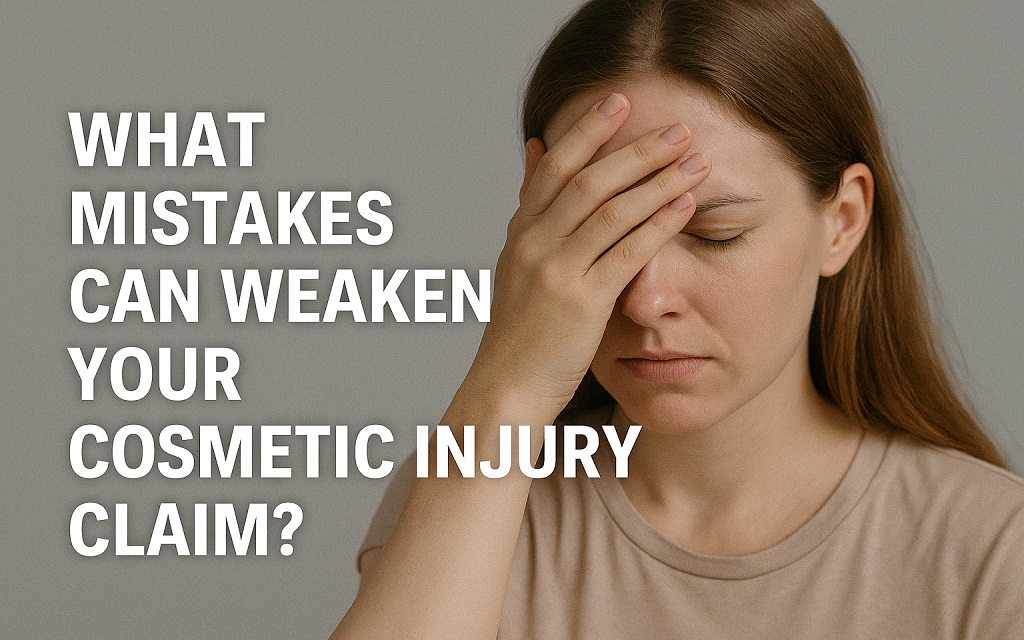
You should avoid common errors that weaken shampoo injury claims. Protecting your legal rights from the beginning is essential. Errors in time or documentation could keep you from getting compensation.
Also, do not throw away the bottle too soon. The label and batch code link your injury to a specific product. If you discard it, the brand may argue that you used a different item.
You should not delay medical care. Early diagnosis supports your timeline and proves harm. If you wait weeks or months before seeing a dermatologist, courts may question the connection to the shampoo.
Do not ignore receipts or proof of purchase. Courts typically require some evidence of product ownership. Loyalty programs, order confirmations, or bank statements help confirm that you used the product at issue.
Also, you should not post claims online before seeing a lawyer. Public videos may later conflict with your testimony. If you post opinions instead of facts, the defense may use that content to challenge your credibility.
You should not stop treatment early. Medical records create the foundation for damages. If you skip follow-ups or fail to complete treatment, your claim for pain or suffering may weaken.
Don’t depend just on your memories. As symptoms appear, dates and pictures should be recorded. That habit strengthens your claim and helps your lawyer build a timeline.
You should not apply other products while investigating an injury. Mixing shampoos, creams, or oils may confuse the source of harm. Your doctor needs clear facts about what you used and when.
However, you should not wait until the deadline nears. Each state sets limits on when you may file. If you contact a lawyer too late, they may not have time to prepare a strong complaint.
Also, you need to build your case step by step. Save the bottle. Visit a doctor. Take photos. Keep receipts. Speak with a lawyer. Every action you take today helps protect your right to fair compensation.

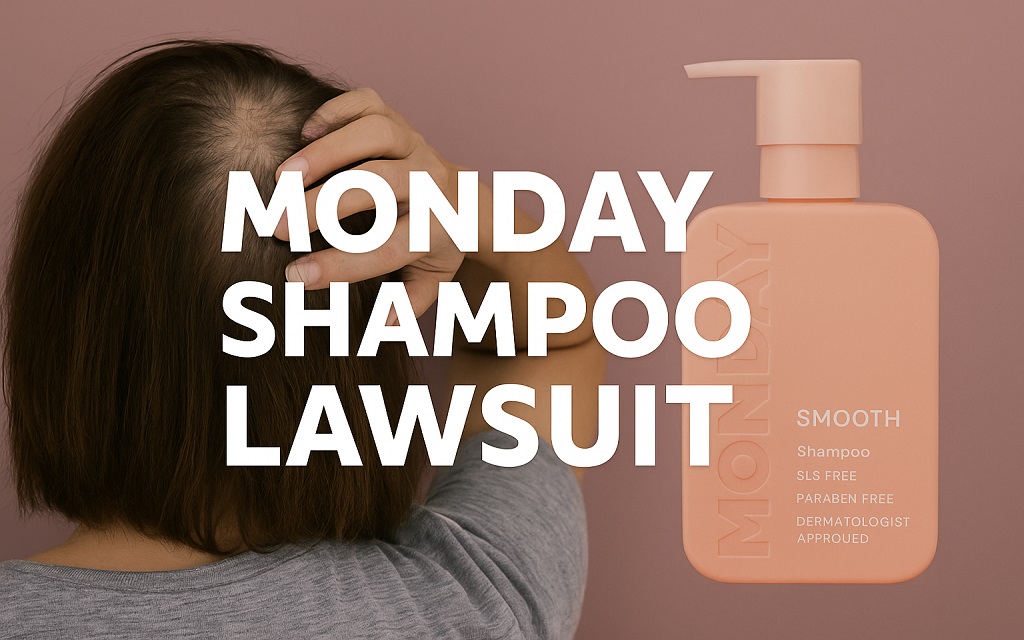

![Read more about the article Miracle Moo Lawsuit: False Supplement Claims, Legal Rights & Class Action Explained [2025 Update]](https://www.judicialocean.com/wp-content/uploads/2025/10/Miracle-Moo-Lawsuit-1-768x480.jpg)
